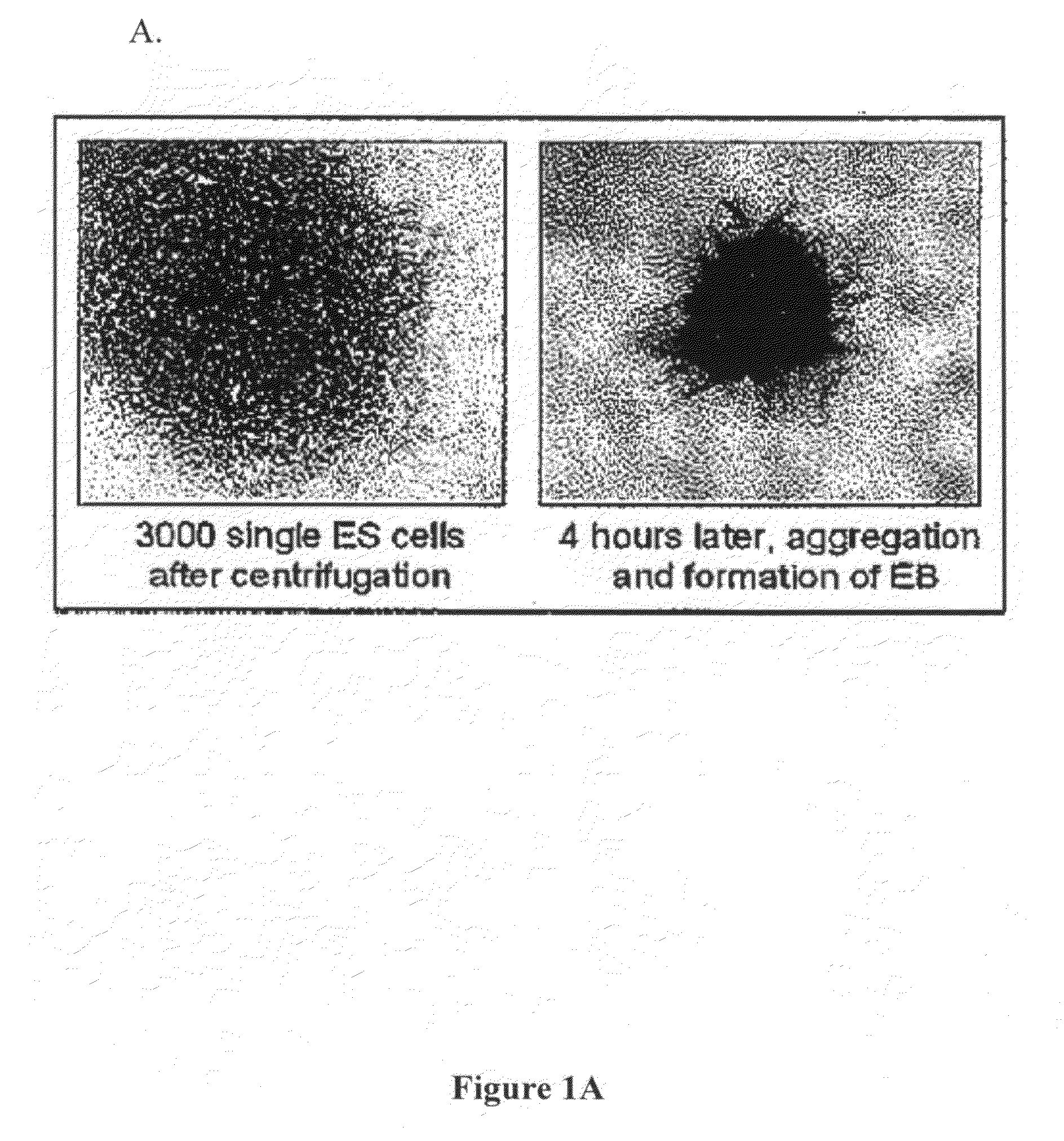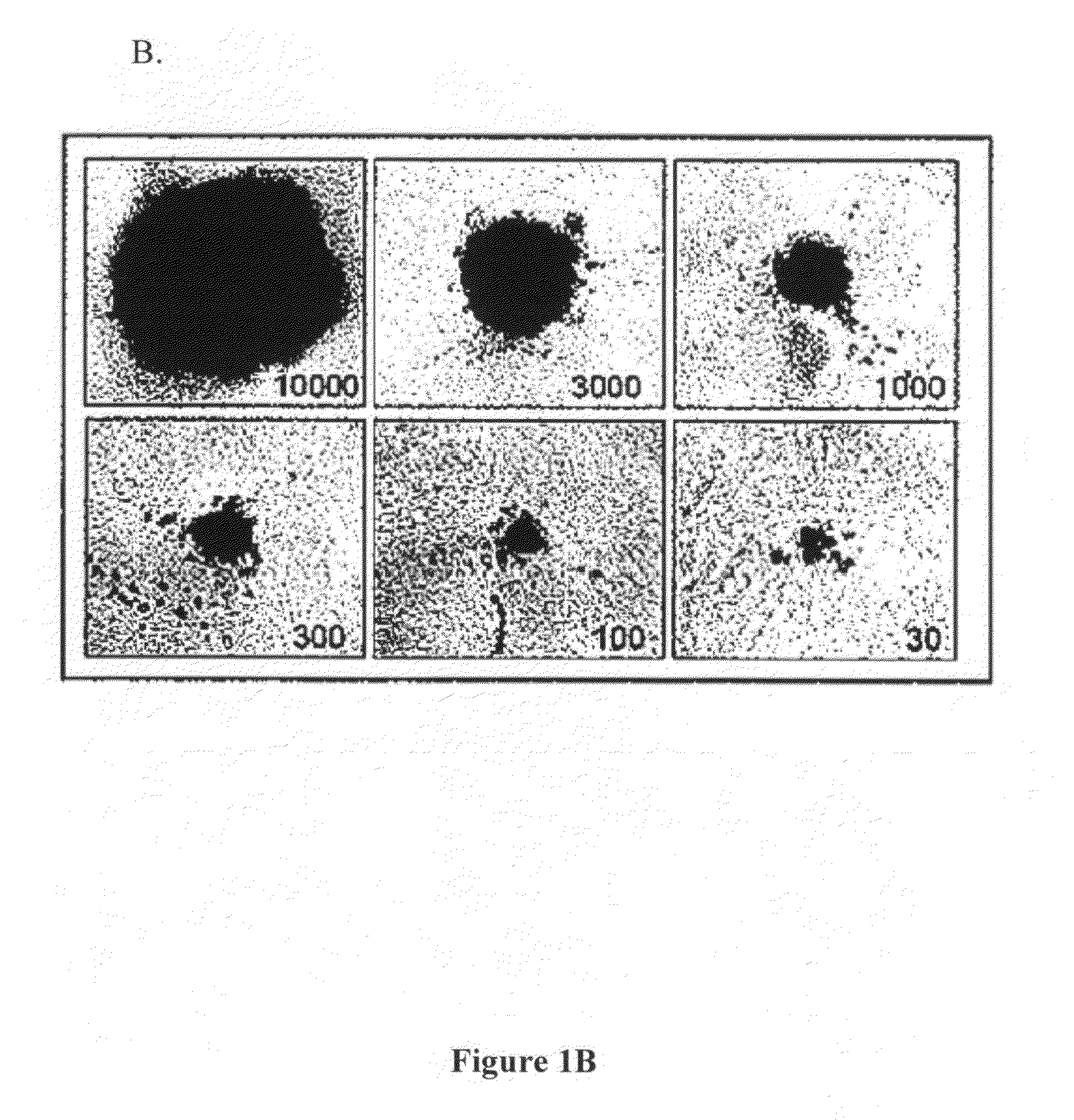Cell matrix related compositions and their use for generating embryoid bodies
- Summary
- Abstract
- Description
- Claims
- Application Information
AI Technical Summary
Benefits of technology
Problems solved by technology
Method used
Image
Examples
example 1
EB Formation in the Presence of Laminin and Nidogen
[0028]1.1 Background
[0029]We have developed a simple method for the efficient generation of human EBs(hEB) from defined numbers of hES cells. The classical method of hEB formation is to plate clumps of partially digested hESC into non-contact tissue culture plates. The suspended clumps then spontaneously differentiate into hEB that vary in size and morphology. A more recent method, called “spin EBs” completely digests hES cells into single cell suspensions that can be counted and manipulated, and then uses centrifugation to re-aggregate hES cells for subsequent differentiation into hEB.
[0030]1.2. Laminin and Nidogen Facilitate EB Formation from hES Cell Suspensions
[0031]We found that using centrifugation to form hEB from single cell suspensions of hES cells is only successful when murine embryonic fibroblasts (MEF) are mixed with hES cells in the cell pellet. Our investigations have shown that two elements when added to the hESC sus...
example 2
Identification of the Critical Extracellular Matrix Proteins that Promote Human Embryonic Stem Cell Assembly
[0034]2.1 Abstract
[0035]Human Embryonic Stem Cells (hESC) exist as large colonies containing tightly adherent, undifferentiated cells. Disaggregation of hESC as single cells significantly affects their survival and differentiation, suggesting that adhesion mechanisms are critical for the assembly and maintenance of hESC colonies. The goal of these studies was to determine the key extracellular matrix (ECM) components that regulate assembly and growth of hESC colonies. Our studies demonstrate that undifferentiated hESC express a specific subtype of laminin (laminin-511) and nidogen-1. The addition of a purified protein complex comprised of human laminin-511 and nidogen-1 to single cell suspensions of hESC is sufficient to restore hESC assembly in the absence of murine embryonic fibroblasts or exogenous chemicals. The mechanism of hESC aggregation is through binding of the α6β1 ...
example 3
LN-EBs Produce ECM Proteins.
[0102]The expression of ECM proteins was examined using antibodies on frozen sections of LN-EBs. LN-EBs produce large amounts of ECM proteins deposited as massive protein islands within the EBs (FIG. 6A), or diffusely distributed within the cellular compartments (FIGS. 6B, 6C, 6D). Frozen sections of LN-EBs were prepared on day 15 of culture and exposed to primary polyclonal antibodies against collagen IV, laminin and nidogen 1, respectively. Then, the sections were exposed to the secondary antibodies conjugated with Cy3 (red color). Nuclei were visualized with Dapi staining (blue).
[0103]In accordance to our PCR data suggesting that laminin 511, nidogen 1 and collagen IV are expressed in undifferentiated hESC, these data demonstrated that human LN-EBs generate large amount of these proteins. Human EBs can therefore be used as a source for human laminin 511 and nidogen 1 and collagen IV production and purification.
[0104]The present invention is not to be l...
PUM
 Login to View More
Login to View More Abstract
Description
Claims
Application Information
 Login to View More
Login to View More - R&D
- Intellectual Property
- Life Sciences
- Materials
- Tech Scout
- Unparalleled Data Quality
- Higher Quality Content
- 60% Fewer Hallucinations
Browse by: Latest US Patents, China's latest patents, Technical Efficacy Thesaurus, Application Domain, Technology Topic, Popular Technical Reports.
© 2025 PatSnap. All rights reserved.Legal|Privacy policy|Modern Slavery Act Transparency Statement|Sitemap|About US| Contact US: help@patsnap.com



